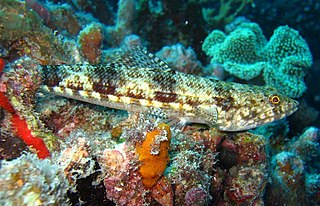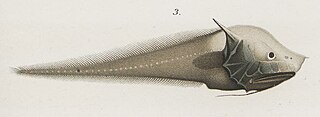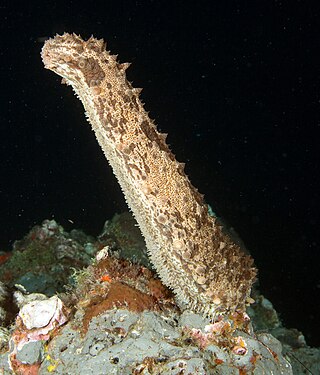
Barracudinas are any member of the marine mesopelagic fish family Paralepididae: 50 or so extant species are found almost worldwide in deep waters. Several genera are known only from fossils dating back to the Ypresian epoch.

Aulopiformes is a diverse order of marine ray-finned fish consisting of some 15 extant and several prehistoric families with about 45 genera and over 230 species. The common names grinners, lizardfishes and allies, or aulopiforms are sometimes used for this group. The scientific name means "Aulopus-shaped", from Aulopus + the standard fish order suffix "-formes". It ultimately derives from Ancient Greek aulós + Latin forma, the former in reference to the elongated shape of many aulopiforms.

Greeneyes are deep-sea aulopiform marine fishes in the small family Chlorophthalmidae. Thought to have a circumglobal distribution in tropical and temperate waters, the family contains just 18 species in two genera. The family name Chlorophthalmidae derives from the Greek words chloros meaning "green" and ophthalmos meaning "eye".

The marine hatchetfishes or deep-sea hatchetfishes as well as the related bottlelights, pearlsides and constellationfishes are small deep-sea ray-finned fish of the stomiiform family Sternoptychidae. They are not closely related to and should not be confused with the freshwater hatchetfishes, which are teleosts in the characiform family Gasteropelecidae. The Sternoptychidae have 10 genera and about 70 species altogether.

Sabertooth or sabretooth fish are small, fierce-looking deep-sea aulopiform fish comprising the family Evermannellidae. The family is small, with just eight species in three genera represented; they are distributed throughout tropical to subtropical waters of the Atlantic, Indian, and Pacific Oceans.

Sir John Murray was a pioneering Canadian-born Scottish oceanographer, marine biologist and limnologist. He is considered to be the father of modern oceanography.

The family Polychelidae contains thirty-eight extant species of blind, benthic lobster-like crustaceans. They are found throughout the world's tropical, sub-tropical and temperate oceans, including the Mediterranean Sea and the Irish Sea.

The Ipnopidae are a family of fishes in the order Aulopiformes. They are small, slender fishes, with maximum length ranging from about 10 to 40 cm. They are found in temperate and tropical deep waters of the Atlantic, Indian, and Pacific Oceans.
Neocyema erythrosoma is a species of pelagic fish, a deep-water bobtail snipe eel in the family Cyematidae. It is the only member of its genus, Neocyema. It was first described by Peter Castle in 1978 after two specimens were caught at great depths in the south Atlantic Ocean in 1971. Further specimens have since been caught in the North Atlantic.
This glossary of ichthyology is a list of definitions of terms and concepts used in ichthyology, the study of fishes.

The deepsea lizardfish, Bathysaurus ferox, is an aulopiform of the family Bathysauridae, found in tropical and subtropical seas across the world. The deepsea lizardfish should not be confused with the true or "typical" lizardfishes of the related family Synodontidae.
A blind fish is a fish without functional eyes. Most blind fish species are found in dark habitats such as the deep ocean, deep river channels and underground.

Ipnops is a genus of deep-sea fish in the family Ipnopidae, which also includes the better-known tripodfish. Ipnops are small, slender fish that live close to the ocean floor in the bathyal and abyssal zones. The genus is notable for its unusual eyes.

Chlorophthalmus is a genus of greeneyes

Bathypterois is a genus of deepsea tripod fishes. They are a diverse genus that belong to the greater family Ipnopidae and order Aulopiformes. They are distinguished by having two elongated pelvic fins and an elongated caudal fin, which allow them to move and stand on the ocean floor, much like a tripod, hence the common name. Bathypterois are distributed worldwide with some particular species of the genus having specialized environmental niches, such as lower dissolved oxygen concentrations. Bathypterois have a reduced eye size, highly specified extended fins, and a mouth adapted to filter feeding. They are filter feeders whose main food source is benthopelagic planktonic calanoid copepods, but some variation is seen with maturity in secondary food sources. Bathypterois use their three elongated fins for a wide range of motion from landing to standing on the ocean floor to catching prey, for which these fins serve as specialized perceptory organs. Bathypterois have both male and female gonads at once making, them simultaneous hermaphrodites, whose gonads go through five stages of development following seasonal autumn spawning.
Barathronus is a genus of deep-sea fish that are placed in the family Aphyonidae or family Bythitidae (brotulas), depending on the source.

The bony-eared assfish is a bathypelagic species of cusk-eel found in tropical and sub-tropical oceans at depths of from 1,171 to 4,415 metres. It has been found as far north as Queen Charlotte Sound off British Columbia's coast. This species grows to a length of 37.5 centimetres (14.8 in) SL. It is the only known member of its genus Acanthonus.
The silver pearlfish, Encheliophis homei, is a species of eel-like fish in the family Carapidae. This pearlfish lives inside the coelom of sea cucumbers such as Bohadschia argus, Thelenota ananas , and Stichopus chloronotus. It is native to tropical and subtropical parts of the Indo-Pacific Ocean.

Melanocetus murrayi, commonly known as Murray's abyssal anglerfish, is a deep sea anglerfish in the family Melanocetidae, found in tropical to temperate parts of the world's oceans at depths down to over 2,000 m (6,600 ft). Its length is up to 13.5 cm (5 in) for females and up to 2.8 cm (1.1 in) for males.

Actinopyga agassizii, commonly known as five-toothed sea cucumber or West Indian sea cucumber, is a species of sea cucumber in the family Holothuriidae. It was first described by German zoologist Emil Selenka in 1867. It is native to the Western Atlantic region, including the Gulf of Mexico and the Caribbean Sea, and is harvested for food.















